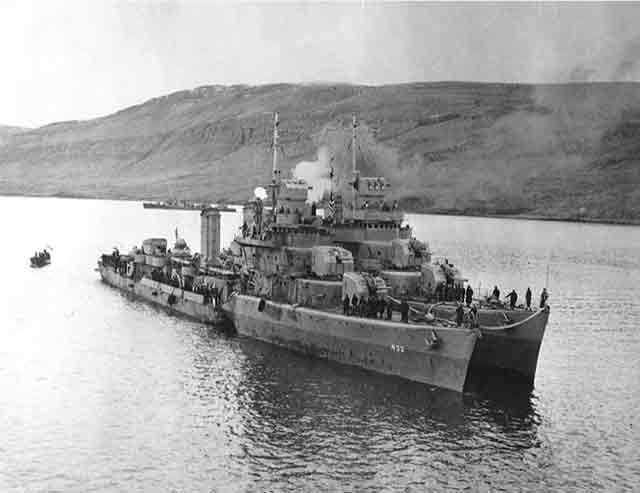Friday 17 October 1941
 |
| USS Kearny photographed in Iceland after its arrival there on 19 October 1941, showing the damage caused by the torpedo attack of 17 October 1941. |
Battle of the Atlantic: Pursuant to President Roosevelt's standing orders for US Navy warships to protect convoys in the North Atlantic, the 1630-ton destroyer USS Kearny (DD-432) is sailing with Convoy SC-48 south of Iceland when disaster strikes. During the night, U-568 (Kptlt. Joachim Preuss), on its second patrol out of St. Nazaire, spots Kearny illuminated by the fires of a burning freighter. Captain Preuss fires one torpedo that strikes Kearny in the starboard forward fire room (roughly amidships). Quick action by the Kearny's crew seals off the flooding, but the ship sustains heavy damage.
 |
| Douglas SBD Dauntless dive bombers of the VS-6 in flight on 17 October 1941. |
Fortunately for the men of the Kearny, the fire room and engine room are separate, and they can use another fire room in the rear of the ship. Thus, it retains engine power despite the damage. The Kearny, under escort by USS Greer (DD-145), makes it safely back to Hvalfjordur, Iceland on the 19th, and then at the end of the year to Boston for repairs. There are 11 deaths and 22 injured, the first combat deaths for the US Navy since World War I. U-568, meanwhile, survives a brief depth charge attack by HMCS Pictou and then escapes on the surface into the night.
 |
| Royal Navy battleship HMS Duke of York in the fitting-out basin at Rosyth, 17 October 1941 (© IWM (A 5917)). |
The Kearny incident reflects the greatly increased (and controversial) role of US Navy ships in the North Atlantic during 1941. The Kearny actively engaged in attacks on U-boats upon arriving at Convoy SC-48 on 16 October, dropping depth charges throughout the morning of the 17th. Thus, it "began hostilities." The entire incident reflects the murky nature of US involvement in World War II in October 1941, as the United States is not at war and at least arguably should not be engaging in military actions unless it
wants to be at war. There are strong arguments of every side of questions like this: in brief, the US maintains that it has a right to keep open its sea lanes and protect its ships, while German views peacetime US military support of England as violating international law. There is nothing that the Reich can do to retaliate directly against the United States following this incident, or vice versa, short of declaring war. However, Hitler does hold a grudge, while Roosevelt decides that now is not the time to declare war. Active US Navy participation in convoy protection is a very sensitive political topic both in 1941 and later.
 |
| Supplies ("comforts") being taken aboard HMS Ramillies at Liverpool, 17 October 1941. © IWM (A 6098). |
Some feel that Roosevelt purposefully putting warships in harm's way is a deliberate provocation. Hitler certainly does. He learns about the entire incident, either through the United States media, his spies, or codebreaking activities. Along with other incidents, he specifically mentions the Kearny incident - highlighting its participation in attacking the U-boats, of course - during his declaration of war on the United States on 11 December 1941.
 |
| German soldiers take the crew of a Soviet T-34 tank prisoner at Kalinin (Tver). T-34 tank number 4 of the 21st Armored Brigade rammed a German self-propelled guns StuG III of Lieutenant Tachinski of the 660th Assault Gun Battery. Both vehicles were put out of action. This was a Soviet raid on German forces at Kalinin, the Germans still attempting to eliminate resistance in the area. Either 17 or 18 October 1941. |
Eastern Front: In the center of the German advance on Moscow, Paul Hausser’s SS-Infanterie-Division (mot.) Das Reich and the attached "Hauenschild Brigade" of 10th Panzer Division batter against the defending Soviet 32nd Siberian Rifle Division from Vladivostok. The battle along the two parallel highways to Moscow (the Minsk and Moscow Highways) takes place at Borodino Field, site of the 1812 Napoleonic battle won by France at great cost. Just as at that earlier battle, the invading force pushes back the heroic defenders after fierce fighting. The Soviet troops fall back on Mozhaysk, the anchor of the main defensive ring around Moscow. The Stavka, alarmed by the continued German advance against elite troops, beings pulling troops north from Ukraine for the defense of Moscow.
 |
| A view of USS Greer showing the damage amidships incurred on 17 October 1941. |
October 1941
October 1, 1941: Germans and Finns Advance in USSR
October 2, 1941: Operation Typhoon Broadens
October 3, 1941: Air Battles Near Moscow
October 4, 1941: Stalin Contemplates Defeat
October 5, 1941: Hoth Goes South
October 6, 1941: First Snowfall After Dark
October 7, 1941: Stalin Gets Religion
October 8, 1941: FDR Promises Stalin Aid
October 9, 1941: FDR Orders Atomic Bomb Research
October 10, 1941: Reichenau's Severity Order
October 11, 1941: Tank Panic in Moscow
October 12, 1941: Spanish Blue Division at the Front
October 13, 1941: Attack on Moscow
October 14, 1941: Germans Take Kalinin
October 15, 1941: Soviets Evacuate Odessa
October 16, 1941: Romanians Occupy Odessa
October 17, 1941: U-568 Torpedoes USS Kearny
October 18, 1941: Tojo Takes Tokyo
October 19, 1941: Germans Take Mozhaysk
October 20, 1941: Germans Attack Toward Tikhvin
October 21, 1941: Rasputitsa Hits Russia
October 22, 1941: Germans Into Moscow's Second Defensive Line
October 23, 1941: The Odessa Massacre
October 24, 1941: Guderian's Desperate Drive North
October 25, 1941: FDR Warns Hitler About Massacres
October 26, 1941: Guderian Drives Toward Tula
October 27, 1941: Manstein Busts Loose
October 28, 1941: Soviet Executions
October 29, 1941: Guderian Reaches Tula
October 30, 1941: Guderian Stopped at Tula
October 31, 1941: USS Reuben James Sunk
2020






No comments:
Post a Comment